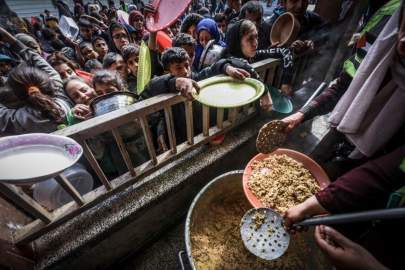Israeli Forces Fire on Palestinian Civilians Amid Aid Delivery Crisis
Thursday, February 29, 2024
Two sides give starkly different accounts after dozens killed; Hamas pauses cease-fire talk
Original Source: Wall Street Journal
By Sune Engel Rasmussen, Margherita Stancati, and Anat Peled. Summer Said, Fatima AbdulKarim and Annie Linskey contributed to this article.
Updated Feb. 29, 2024 3:24 pm ET

TEL AVIV—Israeli troops opened fire on Palestinian civilians as a chaotic series of events unfolded involving a convoy of aid trucks in the Gaza Strip, the Israeli military and Gaza health officials said, prompting Hamas to pause delicate cease-fire negotiations.
The Israeli military and Palestinian witnesses and officials gave conflicting accounts of what happened. Gaza health officials said more than 100 Palestinians were killed and 700 injured.
Israeli officials said thousands of Palestinians surrounded some 30 trucks carrying aid into northern Gaza along the strip’s main seaside road at about 4 a.m. on Thursday. Dozens were fatally trampled or injured in the crush, and some were run over by the trucks, Israeli officials said.
Soon after, officials said, troops a short distance down the road from the aid convoy opened fire on a crowd that approached a military checkpoint and ignored warning shots. A military spokesman said that the shooting was under investigation and that it could have caused deaths and injuries.
Three witnesses said Israeli soldiers and tanks fired at people waiting for aid deliveries near the Nabulsi roundabout in northern Gaza. They said the shooting started before they saw the trucks arrive.
Saeb Abu Sultan, a 36-year-old father of three, said he had been reluctant to collect aid because he had heard people were sometimes shot around checkpoints, and he found it humiliating. But on Thursday he went for the first time because his family hadn’t eaten in two days.
“I knew it was a risk,” he said. “But to our shock, Israeli military vehicles were coming toward Duwar Nabulsi and opened fire toward the people and we started running,” he said. “The trucks didn’t stop. I swear there were people under the trucks.”
Israeli military spokesman Daniel Hagari, in a briefing Thursday evening, said the aid convoy was coordinated by the Israeli military for distribution by private contractors, and that Israeli soldiers and tanks were present to secure the humanitarian corridor. Hagari said thousands of Palestinians began “violently pushing and even trampling other Gazans to death,” resulting in dozens killed and injured. Hagari added that Israel had organized similar convoys for four nights without incident.
Olivia Dalton, a White House spokeswoman, said, “We think that this latest event needs to be thoroughly investigated.”
Aid deliveries to Gaza have become dangerous missions as law and order have broken down in some parts of the enclave after almost five months of war and the population has grown increasingly desperate as supplies of food and medicine run short. Police working for Hamas have largely vanished from the streets.
Efforts to provide essentials for the population of Gaza have been paralyzed by curbs on aid flowing into the enclave, Israeli strikes on aid trucks and violent attacks on aid deliveries by hungry Palestinians.
The convoy incident came as the death toll in Gaza surpassed 30,000 people killed since Israel responded to an Oct. 7 Hamas attack on southern Israel that authorities say killed 1,200 people in the deadliest day for Jews since the Holocaust.
The total death toll from the war—equivalent to about 1.3% of Gaza’s entire population—includes more than 12,500 children and over 8,500 women, around two-thirds of the total, according to Palestinian health authorities, whose figures don’t distinguish between civilians and militants. Hagari on Thursday said Israel has killed 13,000 militants since the war’s start.
About 75,000 people have been injured and two million displaced by the fighting, more than half of them crammed into Rafah, Gaza’s southernmost city, near the Egyptian border. Israel has said it would launch an offensive in Rafah if a cease-fire deal isn’t reached before the Muslim holy month of Ramadan, set to begin around March 10.
Gaza has been under Israeli and Egyptian blockade since Hamas took control of the enclave in 2007. Before the war, around 600 commercial and air trucks entered Gaza each day. Since then, Israel has severely constricted the flow of aid into Gaza, allowing food, water, medicines and sheltering equipment but blocking almost everything else. In February, an average of 98 trucks a day entered the strip, a 50% fall from January, according to the U.N.
Aid trucks that enter Gaza have to pass through Israeli military checkpoints to receive approval, and while they wait, often for lengthy periods, crowds of people gather. Looting has become frequent in recent weeks, according to the U.N., which is leading the humanitarian response.
The Israeli military has denied access to most humanitarian missions to the north on security grounds. The U.N. has complained to the Israeli military about the long waits.
In recent weeks, the Israeli military has resumed bombings in the north after a resurgence of Hamas fighters there. Israel said Thursday that its forces had recently killed several Palestinian militants in the Zeitoun neighborhood of Gaza City in addition to destroying tunnel shafts and confiscating weapons. The Israeli military has also renewed airstrikes and other operations in the southern city of Khan Younis, where most of its forces are concentrated.
U.S. and Arab negotiators are pushing Israel and Hamas to agree by next week to a deal that would ease the humanitarian crisis in Gaza by allowing in more aid deliveries, pause fighting and release hostages. Of the more than 200 hostages taken during the Oct. 7 attack, 130 remain in captivity, including 31 dead bodies, according to the Israeli prime minister’s office.
President Biden, asked whether Thursday’s incident in Gaza would complicate cease-fire negotiations, said, “I know it will.” He said he was still hopeful of a deal, but not by Monday, as he had initially hoped.
One of the main sticking points is a disagreement between Israel and Hamas over the ratio of Palestinian prisoners who would be released in return for hostages. Another stumbling block is the limited and gradual return of Palestinians to their homes in the north of Gaza during any potential truce. Israelis have said they would be willing to allow women and children to return, but most male Palestinians would be held back, Egyptian officials said.











